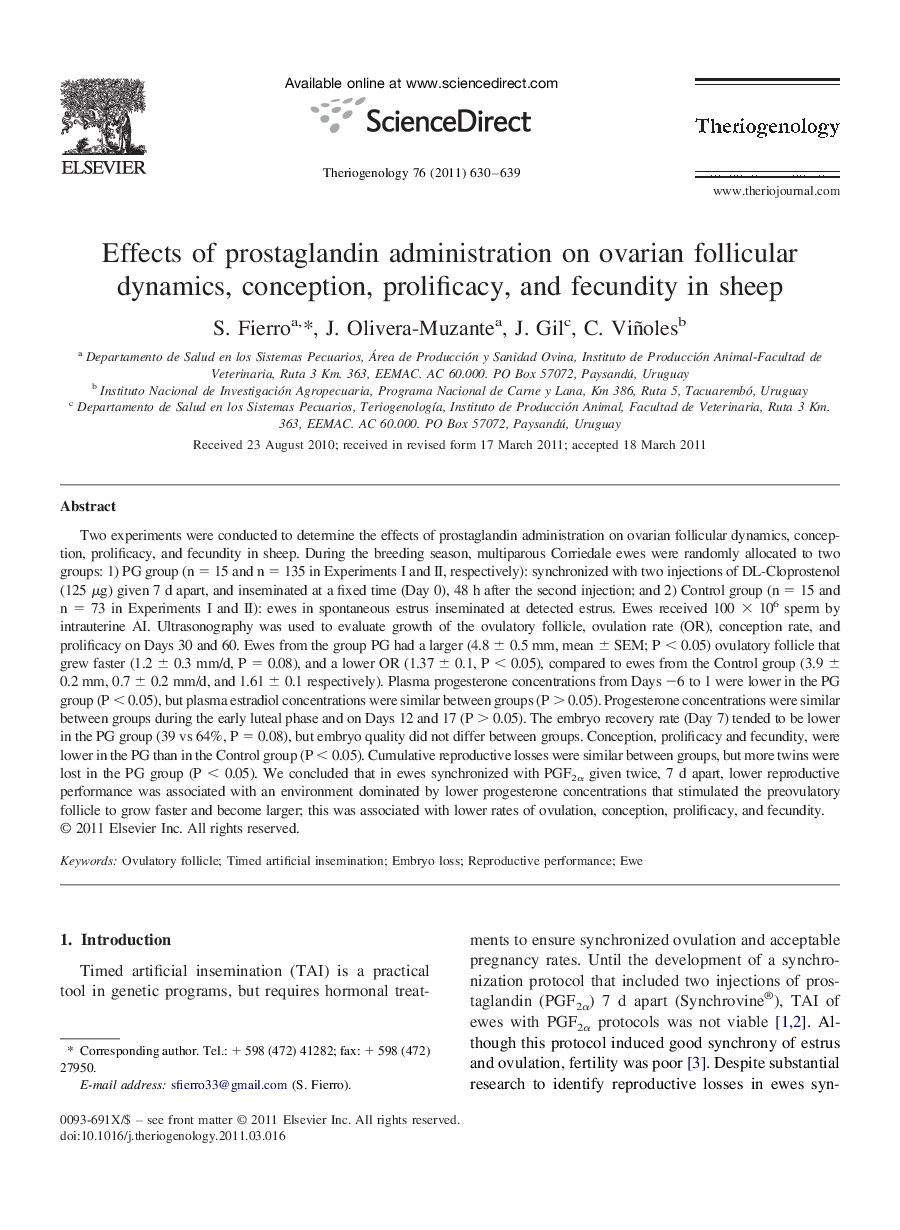| کد مقاله | کد نشریه | سال انتشار | مقاله انگلیسی | نسخه تمام متن |
|---|---|---|---|---|
| 10893011 | 1082136 | 2011 | 10 صفحه PDF | دانلود رایگان |
عنوان انگلیسی مقاله ISI
Effects of prostaglandin administration on ovarian follicular dynamics, conception, prolificacy, and fecundity in sheep
دانلود مقاله + سفارش ترجمه
دانلود مقاله ISI انگلیسی
رایگان برای ایرانیان
کلمات کلیدی
موضوعات مرتبط
علوم زیستی و بیوفناوری
علوم کشاورزی و بیولوژیک
علوم دامی و جانورشناسی
پیش نمایش صفحه اول مقاله

چکیده انگلیسی
Two experiments were conducted to determine the effects of prostaglandin administration on ovarian follicular dynamics, conception, prolificacy, and fecundity in sheep. During the breeding season, multiparous Corriedale ewes were randomly allocated to two groups: 1) PG group (n = 15 and n = 135 in Experiments I and II, respectively): synchronized with two injections of DL-Cloprostenol (125 μg) given 7 d apart, and inseminated at a fixed time (Day 0), 48 h after the second injection; and 2) Control group (n = 15 and n = 73 in Experiments I and II): ewes in spontaneous estrus inseminated at detected estrus. Ewes received 100 à 106 sperm by intrauterine AI. Ultrasonography was used to evaluate growth of the ovulatory follicle, ovulation rate (OR), conception rate, and prolificacy on Days 30 and 60. Ewes from the group PG had a larger (4.8 ± 0.5 mm, mean ± SEM; P < 0.05) ovulatory follicle that grew faster (1.2 ± 0.3 mm/d, P = 0.08), and a lower OR (1.37 ± 0.1, P < 0.05), compared to ewes from the Control group (3.9 ± 0.2 mm, 0.7 ± 0.2 mm/d, and 1.61 ± 0.1 respectively). Plasma progesterone concentrations from Days â6 to 1 were lower in the PG group (P < 0.05), but plasma estradiol concentrations were similar between groups (P > 0.05). Progesterone concentrations were similar between groups during the early luteal phase and on Days 12 and 17 (P > 0.05). The embryo recovery rate (Day 7) tended to be lower in the PG group (39 vs 64%, P = 0.08), but embryo quality did not differ between groups. Conception, prolificacy and fecundity, were lower in the PG than in the Control group (P < 0.05). Cumulative reproductive losses were similar between groups, but more twins were lost in the PG group (P < 0.05). We concluded that in ewes synchronized with PGF2α given twice, 7 d apart, lower reproductive performance was associated with an environment dominated by lower progesterone concentrations that stimulated the preovulatory follicle to grow faster and become larger; this was associated with lower rates of ovulation, conception, prolificacy, and fecundity.
ناشر
Database: Elsevier - ScienceDirect (ساینس دایرکت)
Journal: Theriogenology - Volume 76, Issue 4, 1 September 2011, Pages 630-639
Journal: Theriogenology - Volume 76, Issue 4, 1 September 2011, Pages 630-639
نویسندگان
S. Fierro, J. Olivera-Muzante, J. Gil, C. Viñoles,